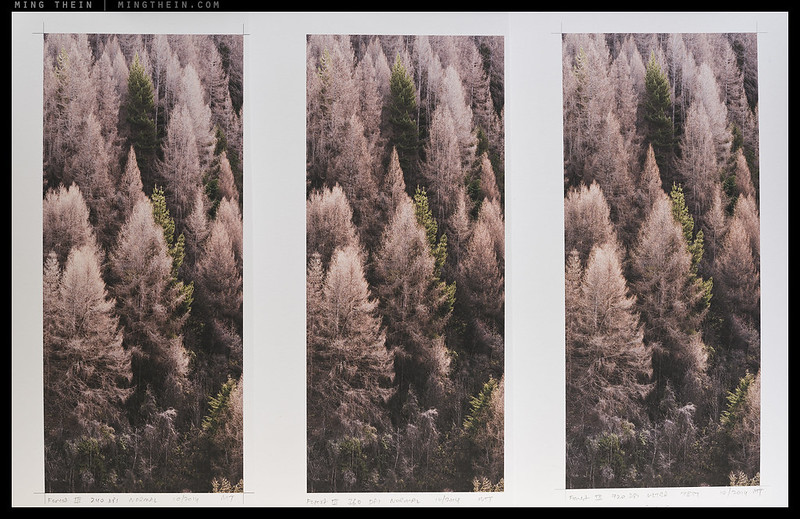
The comparison. This is your field of view at about a foot and a half viewing distance of the crops, which are 10″ high each. Larger version here.
Today’s post is an attempt to do try to convey just how much of a difference there is between an Ultraprint and what would be considered a normal, very good print. Since this is really impossible without seeing the prints in person, a direct comparison is perhaps the closest I can get when working via the internet. What you see here will come as no surprise to people who’ve bought the most recent one or two Ultraprints from Forest III onwards; however, things have moved on a bit since then.
What I’ve done is printed the same file at several output resolutions, with various combinations of settings and hardware (Ultraprints are modified-hardware dependent, too). I’ve used the same paper to keep things consistent – a matte Canson Baryta Photographique, which we’re experimenting with for pushing resolution and ink density even further for non-reflective prints. Here, I’ve taken a 10×4.5″ section of Forest III (full image above) and printed it on a conventional printer at 240PPI*; then again at 360PPI with Ultraprint hardware and settings; and finally, at 720PPI, again with Ultraprint hardware and settings. The original full image is 40×15″.
*Pixels, not dots per inch – you need many ink dots to make up one pixel equivalent – basically, multiply it by your printer’s number of ink colors.
Here are high-magnification versions from several areas of the images, shot with a D810 and Nikon 60mm macro (for both resolution and a relatively human-scale perspective). Viewing the closeup crops as-presented on a 15″ wide monitor would be equivalent to viewing at 6-8 inches from the actual print. The 100% version would obviously be much, much greater. Click on the images to view larger versions.
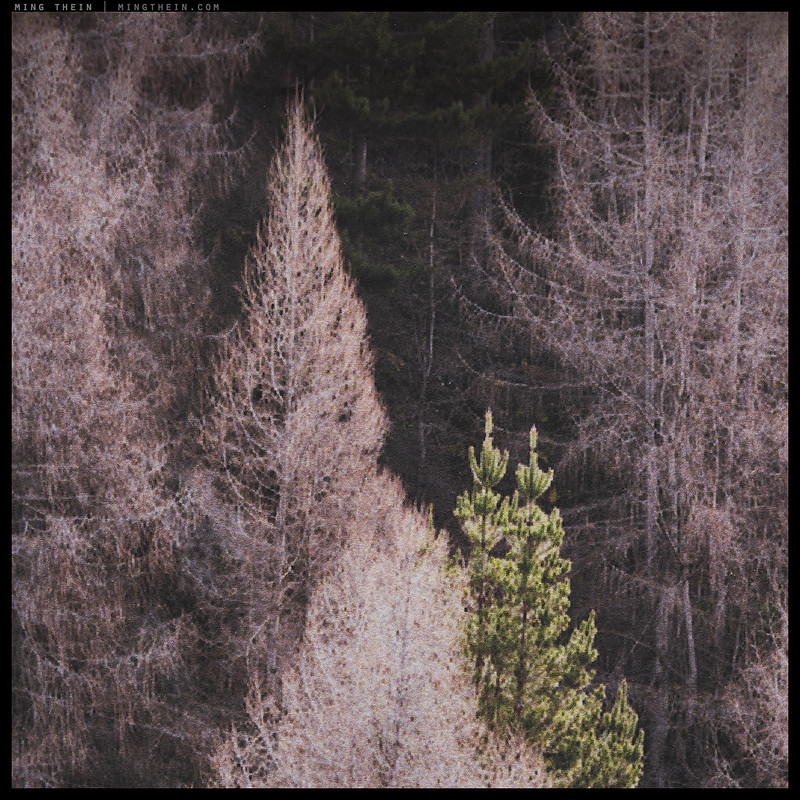
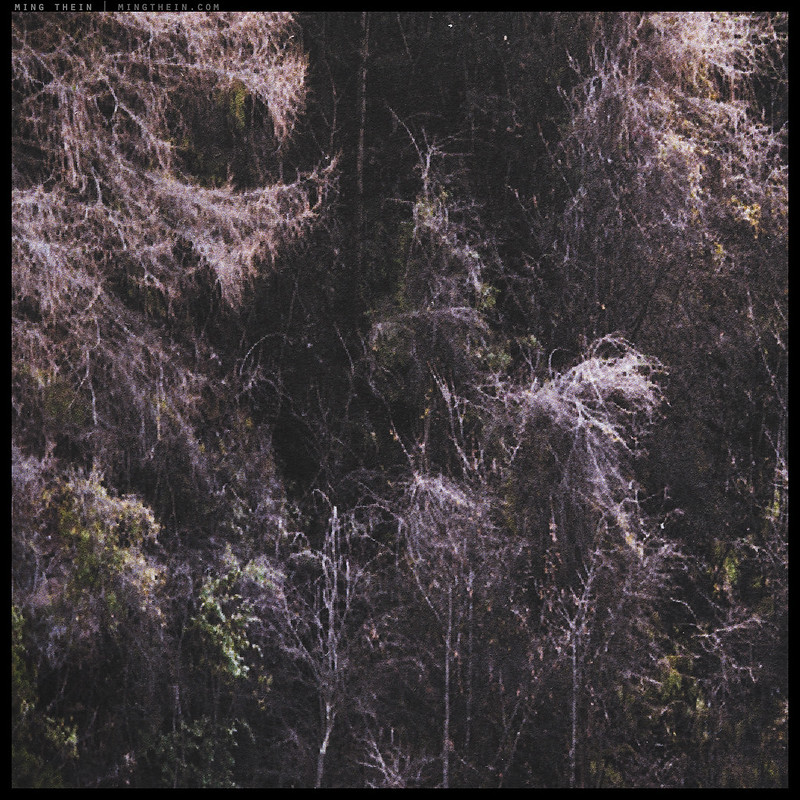
240PPI, equivalent to a standard print
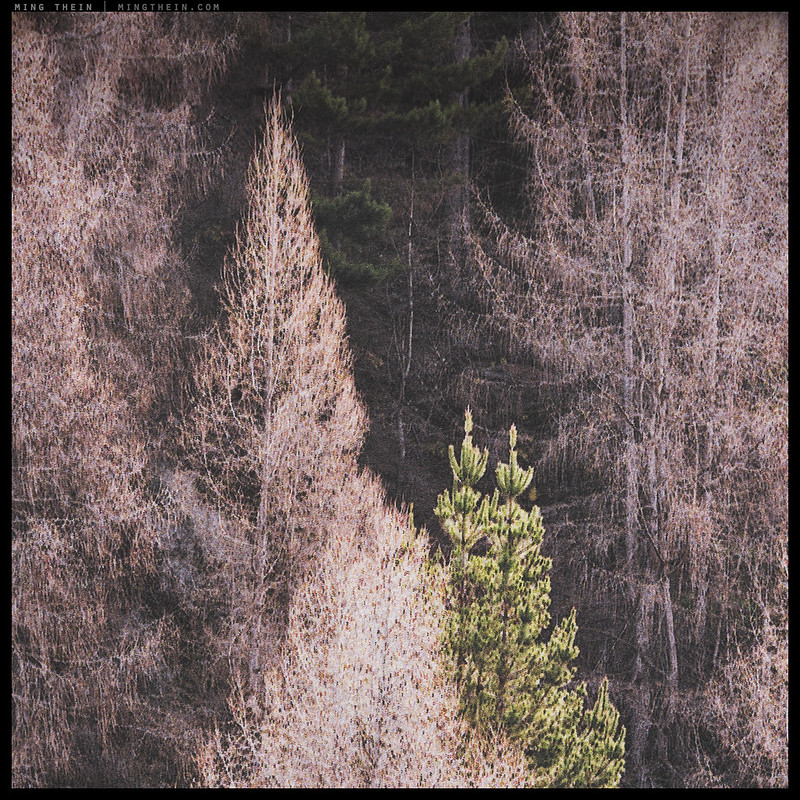

360PPI with latest generation Ultraprint process and hardware, equivalent to first generation 720PPI Ultraprint
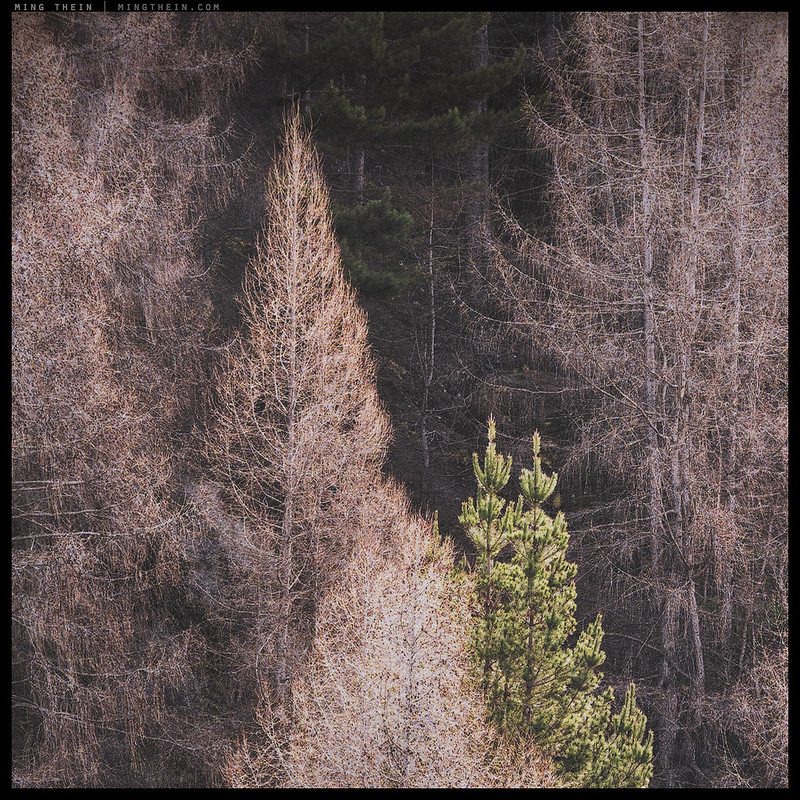

720PPI, latest 3rd-generation Ultraprint
And finally, for scale: that black thing is a human hair, and you’re looking at about 50mm square on the final print. Note how in the larger version you can see detail that is clearly finer than the hair – at times up to 1/3rd the width or thereabouts. Are we in contact printing territory? I think so; it’s pretty much at the limits of what the (already very smooth, and baryta-coated) paper can resolve.

720PPI, latest 3rd-generation Ultraprint. Larger version
I believe there are several conclusions you can come to easily:
- At 2ft viewing distances, all three look pretty good – this would be considered relatively close viewing for a print that’s in itself 3.5ft long, because you already cannot take in the entire image at a single glance.
- At 1ft viewing distance, it’s clear from the 240PPI image that you are looking at a print, and it’s beginning to appear resolution-limited especially in the high frequency/low contrast details read, such as the tops of the trees, and there are limits in resolution – within expected tolerances. The 360PPI and 720PPI images still look good. There’s also a subtle but noticeable difference in color between the three; the higher the resolution, the more subtle and rich colours appear. This is easily explained: the more ink dots you can lay down, the finer the tonal and spectral gradations are possible. Print resolution affects tonality.
- At 6″ viewing distance, which is about the limit for most people’s eyes, the 360PPI image is clearly resolution image. The 720PPI image still appears to have more detail – it is actually at about the practical limit of what a person with perfect eyesight can resolve, and also (for now) the limits of the hardware and media. I’m not even going to talk about the 240PPI image.
I have chosen subject matter that does have an enormous amount of high frequency detail, but even on subjects that do not, the tonal benefits still apply; large areas of color are seldom a single RGB value, but display subtle shifts which we register only subconsciously in real life. However, my Ultraprints do faithfully replicate this.
The net difference is one of immersiveness and transparency. This is obviously not suitable or desirable for all subject matter and artistic intention, but my creative aim is to find ways to deploy this to maximum effect; so far, natural scenes seem to benefit the most. It is worth mentioning that due to improvements in both capture and print workflow, hardware and process, the first generation of Ultraprints (e.g. Autumn in Tokyo) sits somewhere between the 360PPI and 720PPI examples, perceptually; closer to the 360PPI side, I’d say. Everything from New Zealand onwards is at the 720PPI end; the effect in person is rather difficult to describe, but extremely three-dimensional. I am now experimenting with much larger – 2x3ft – prints from stitched images at the first generation Ultraprint level; they look better at close range than the 360PPI swatch above. The impact of these is even greater; size really does matter, and even at 1ft viewing distance, the prints have more information than the eye can resolve. Immersive? Most definitely; it’s like looking through a window. Of course, I’d like to go to 720PPI on everything, but some subject matter makes this impossible: anything that moves, for instance. Even slight breezes affecting leaves or blades of grass will be visible, and a colossal pain to stitch properly.
Tomorrow, I’ll be announcing the largest Ultraprint yet at 20×30″. It is made from a truly enormous file, sufficient to be printed at 720PPI – we profiled and completed the proof a couple of weeks ago, and I am proud to say this is the most impressive viewing experience yet – it is no longer a print or an image, but a slice of reality, shrunk in one dimension and preserved for posterity. It has room to breathe, and still room for details – the kind of image you can get lost in. MT
Note: Ultraprinting is a proprietary, exclusive process to my work alone and requires special end to end workflow, special hardware, and suitable compositions/ aesthetics to ‘work’. It is not merely printing!
__________________
Limited edition Ultraprints of these images and others are available from mingthein.gallery
__________________
Visit the Teaching Store to up your photographic game – including workshop and Photoshop Workflow videos and the customized Email School of Photography; or go mobile with the Photography Compendium for iPad. You can also get your gear from B&H and Amazon. Prices are the same as normal, however a small portion of your purchase value is referred back to me. Thanks!
Don’t forget to like us on Facebook and join the reader Flickr group!
Images and content copyright Ming Thein | mingthein.com 2012 onwards. All rights reserved
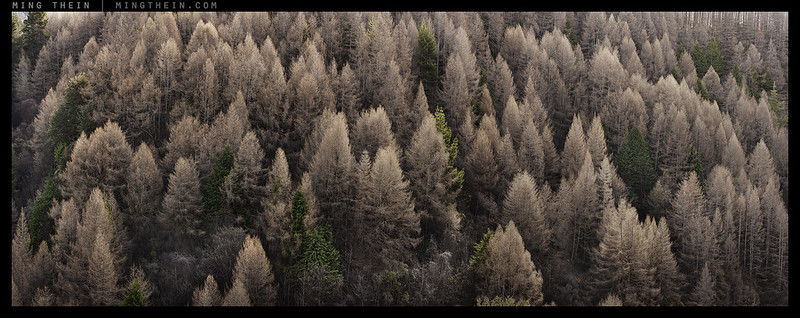






Hello Ming – Over the years I too have found contact or for that matter enlarged prints from large format compelling but will not go through the process of lugging that gear around not to mention going back to film processing and printing. I am trying to get my mind around some of the details for high resolution printing. You mention that ultraprinting requires approximately 780 ppi. Would a file from a camera shooting 6016 x 4016 (24Mp) then yield a 7.7 x 5.14 in. print? Also, the Epson 9900 printer specifications state dpi of 2880 x 1440. If this is divided by 11 colors to get pixel count, I come up with 261 x 130 ppi. How then do you get to 780? What am I missing? Thanks.
It’s 720, though anything north of 550 can sometimes be indistinguishable depending on the spatial frequency and tonal nature of the subject – and the viewer’s eyesight. 550PPI yields about 11″ from a 24MP file. The 9900 has only 9 active inks at any time (matte/gloss sets) for 320 PPI. We are using hardware and software modifications to achieve 720.
Does that mean there will be a 3rd-gen print run of the Lone Tree from Autumn In Tokyo? If so, count me in :)!
No, I won’t be reprinting those images at that size again – and the original files are not the same quality as the ones I’m producing now, so I’m afraid it’s impossible 🙂
Not at that size – what about a different size then? How large could the print be while maxing out resolution? I’m still interested 😉
Divide your pixel dimensions by 720.
Since it’s your image only you know the pixel dimensions… I was just asking at what size you might be offering a second print run.
Sorry, wasn’t clear before – I won’t be doing another run because I promised that image would not be printed again after the first run.
Too bad 😦
I’ll keep watching your print section more frequently then!
Reblogged this on Eileen Lyn Wah.
So wait, this means I need a third gen print to compare against the first two? 😉
I’m going to be moving houses soon, once done I’ll be ordering another one for sure…..
‘Need’ is subjective, but I’d venture a ‘yes’… 😉
Hehe, well I’m a big fan of ultra prints 🙂
Btw, the nob hill one is absolutely massive – no doubt to the buyers that the immersive experience will be quite special.
It really has to be seen. Sadly I’m getting a lot of negative feedback from people who cannot imagine beyond small web images…
Interesting stuff, and demonstrates well the benefits. Do you think the future of ultraprinting is larger wall prints or books? I’m inclined to think that lying in bed with a book of ultraprints is the way forward. I believe that many ‘togs that create a lot of images would prefer to store them as ultraprint books rather than running out of wall space.
There’s no shortcut or economic benefit to more area, which means books are just too costly to produce – we have to print each page individually, and of course double-sided spreads would be out of the question.
The whole point of the Ultraprints was to produce something that would use all of the information but in a more manageable size; of course larger has even more impact, but I’m limited to subjects that don’t move, and as you say – the wall space problem.
I would imagine the first time seeing one of your ultraprints is like having the “scales removed from your eyes”. I look forward to my descaling! Surely this is a concept that requires a standing exhibition? Any plans? Maybe in a year or two when you have settled on your process and have a curated body of work created using the workflow? I applaud you for your efforts to drive photographic (r?)evolution.
Thanks Ian. Two exhibitions on the cards for 2015, in Chicago and Hong Kong.
Aha! Well, a trip may be in order 🙂
Great to see you in Hong Kong (again). Hope you enjoyed the shoot. Take care and see you soon.
I did. Always love working on construction sites because of the huge variety of subject matter – thank you! Until the next time.
Very, very impressive. Unfortunately by the moment I need all my money for other things, but for sure one day I will get one of your ultraprints. I want I slice of other reality hanging on my wall. Greetings.
🙂
extremely cool. no doubt that 720 print is insanely detailed!
do you have a basic math that equates the file’s original (from camera) pixel dimensions with ideal/max print size (obviously if the file is nice and sharp/in focus to begin with). say 8000 pixels across = 2 feet across print? 4 feet across print? that sort of thing.
in past i’ve printed 12000-13000 pixel across panos at about 4.5 feet long and been very pleased with the detail retention (compared to my usual small 4000 across files) but curious about how big it could really be if i maxed it out.
thanks again!
Yes – divide your pixel length by 720… 😉
ha! nicely done.
so I’m assuming that there is no interpolation etc involved? meaning that 720 dpi is directly related to actual pixels from the sensor? i sometimes get confused with enlargement tricks but always try to just think actual pixels = dpi (even tho i tend to export at more dpi than pixels, slightly oversampling)
thanks again for the great work. people do not concentrate on these kind of details enough imo.
No interpolation. DPI involves interpolation because you’re translating a pixel into ink dots; you need many ink dots to make up one pixel because of the intermediate colours and not having a billion ink tanks. PPI is pixels per inch and uninterpolated.
right!
you are seriously packing in the pixels.
from my casual observations many top pros look to be doing 4 foot and up prints from 10,000 across images (ie a single frame from a phase one IQ 180 back). looks like you might be trying to double the pixel density per inch of printed image.
you are raising the bar…..nice!
More than double, plus there’s an additional gain in the very tight droplet sizes/ precision inj laying we’ve managed.
extremely cool….obviously the mechanics of how the printer lays down the information much be critical to realizing these super high density files to their best advantage. even my nice stedl books show the tolerances of the print heads if you look closely enough….
Ming, that is astonishing. I hope you realize that it’s your personal articles, bringing forth novel thoughts and discussing advanced technique, that are the gems of this site, and eventually mainstay of the legacy you are leaving behind; that is knowledge. As compelling as your reviews are, please don’t waste your time with them when they bring neither fun nor money. Especially not when so many people are already hard-pressed to even use their existing gear to its fullest. Thanks for engaging with the people so much, it’s truly admirable.
Thank you.
Kenneth, me and many other people like to read reviews, because they are a very useful guide. If you don’t want to read reviews don’t do it, but let other people do it. Best wishes.
Can’t wait to see what you will show us tomorrow 😉
I have to agree on my new acquired Toshiba Satellite P50t-B-108 Ultra HD (my old notebook hdd was damaged)…never saw images with more fine details (leaves etc.), so crispy and sharp…
Better and much more interesting than any review by the way 😉 Excellent lenses (optics) and displays have much more to keep up with the speed of the development of high resolution sensors……the sensors are thousand miles ahead…in theory 4k only means 8MP…which can be already achieved with a d7000 or em1 and a good lens in terms of sharpness/ MP for web purposes at least…let alone (ultra) printing, details, color rendering…..so this is where Ming’s statement comes into play: sufficiency! 😉
Have a great day- have a Kit Kat ;)!
Wow! Viewed on a retina display iPad, the differences are significant. The actual print must be quite mind-blowing in comparison.
A retina iPad is somewhere around the middle 360PPI mark. There’s an easy way to find out about the prints, I do offer them for sale 🙂
And that’s why I use the iPad to view your (and other) photo blogs, because the difference is apparent. I thought retina was a “gimmick” until I started using it. 😉
Heh, you’ve got lots of nice things I want, Ming, and believe me, I’m saving! But I think education has to come before prints, unless someone chooses to offer me my choice of presents. 😄
The most difficult thing will be choosing…because so many of your pictures have great appeal to me. And that’s no bad thing, I think. 😄
tech side note re retina: i was intrigued to notice (as an apple user) that the samsung note 4 has better pixel density than the iphone 6 plus (401 ppi on a 1920 X 1080 res screen). obviously the note 4 has a smaller screen than an ipad…but i can imagine that just having 515 ppi density on a 5.7 inch screen looks pretty spectacular in the palm of your hand. 2560 x 1440 res on a phone…..significantly higher real resolution than a blu ray disc/iphone 6 plus (1920 x 1080).
Interesting. Of course, pixel density and screen size matter in different ways. Viewing photographs on a 10″ screen is easier on the eye, with sufficient detail than on a smaller phone screen. But it does make for an interesting comparison, and the question of “sufficiency😉” and how much further big (laptop and up to TV) screens can benefit from ultimate pixel density. I think Ming touched upon this when he talked about the new wave of huge TV screens as a display medium. I surely would love a superHD 56″ or upward display screen that could be accurately calibrated. But I digress…😉
I’d like to have both size AND density – and then we get ever closer to reality, preserved…
even a 4k tv does not have the resolution of a d800….not even very close actually. however a well rendered d800/810 etc file would look spectacular on a well calibrated 4 k display (either desk top OR a giant tv on the wall). the thing that it is interesting about very small high density display like the Note 4 is it conveys a different “thing” like a little jewel in the hand rather than an overwhelming wall filling print at a big gallery. both are pretty cool.
You’d need a *clean at the pixel level* 4MP for an image to look good on that screen, which means for most cameras a degree of over sampling. And that’s a 5.7″ ‘print’ – I think you can see why I need every single bit of resolution I can get now…
exactly….i never would have imagined that a PHONE SCREEN could possibly be a demanding medium for the photographer….but there it is. an amazing technical achievement imo. a well executed file will definitely shine even on that tiny 5.7 inch screen.
🙂 that’s a good problem to have (and a good problem for me to hear about!)
Amazing — I’m not even sure which generation of prints I have, except for the Tokyo prints. Were the Cuban prints 2nd gen or later? And have you guys measured how much ink per unit area it takes to print a 720 PPI image?
Cuba is 2nd generation. You’ve got 1st and 2nd.
Actually, printing at 720ppi uses less ink – too much ink results in big dot gain and ‘spread’, which destroys acuity and smoothness of tonal transition.
Ah thanks. And the New Zealand prints (river and tree)? Which printer did you guys use for the 240ppi print?
NZ is generation 2.5; we were in the process of switching to matte paper then (which has a different tonal response and requires some serious recalibration/ reprofiling). All of the comparison prints here were made with the same modified Epson 9900!
Modified Epson 9900????
Yes.